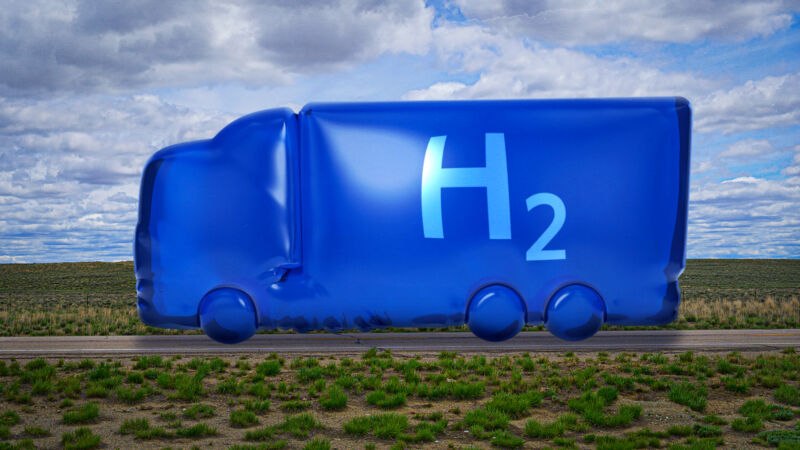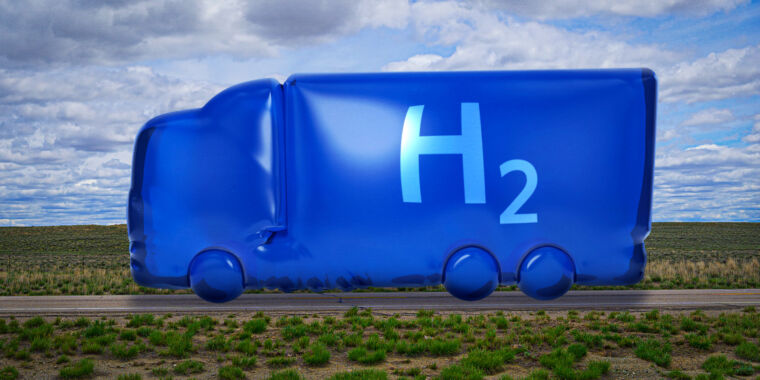
Aurich Lawson | Getty Images
Earth Day is April 22, and its usual message—take care of our planet—has been given added urgency by the challenges highlighted in the latest IPCC report. This year, Ars is taking a look at the technologies we normally cover, from cars to chipmaking, and finding out how we can boost their sustainability and minimize their climate impact.
You can understand why the idea of a hydrogen-powered car is appealing. Humans aren’t great at accepting change, but we do find comfort in the familiar. Being told that our transport must decarbonize means more change. While electric vehicles are better at almost everything, even the world’s biggest EV evangelist must concede that charging a car takes longer than filling a fuel tank. Hydrogen can be pressurized and pumped, and hydrogen can be clean, therefore hydrogen-powered cars make sense, the argument goes.
That’s probably all the prompt any regular Ars Technica reader needs to list the reasons why hydrogen is a non-starter. Like mammals after the Chicxulub asteroid, battery electric vehicles are poised to fill the niches soon to be left by the dinosaurs, in this case fossil fuel-powered vehicles, leaving alternative fuels like hydrogen evaporating into thin air.
But don’t count the universe’s simplest molecule out just yet. While it’s unlikely to catch on in the near future for light passenger vehicles, there are commercial applications like trucks, trains, and other heavy equipment where it does make sense. (For this entire article, we’re talking about green hydrogen, made of wind or solar energy; using fossil fuels to make hydrogen—even with carbon capture—offers little to no benefit. Unfortunately, the vast majority of hydrogen currently produced is derived from hydrocarbons.)
Forget about hydrogen cars—at least for now
There are two main ways to use hydrogen to power a vehicle. You can burn pressurized hydrogen in an internal combustion engine or use the hydrogen in a fuel cell to generate electricity to power electric motors.
Burning hydrogen in an internal combustion engine is probably the most straightforward in terms of existing tech—after modifications to the engine and fuel system, the rest of the car’s powertrain remains the same. And the only exhaust product is water. But hydrogen has little energy density, with just a single covalent bond between two atoms to be broken. Hydrogen combustion engines also make little power, and very inefficiently compared to a similar engine burning gasoline.
So, BMW’s 2006 Hydrogen 7 used a modified version of the company’s V12 engine that, burning hydrogen, generated about 60 percent as much power as the gasoline-burning V12 and required five times as much fuel to do so.
Hydrogen fuel cells have a lengthier automotive history: the first was the General Motors Electrovan in 1966, which had a curb weight that would shame even a Hummer EV and used actual space-age technology. By the mid-2010s, automaker interest in fuel cells was surging, with Audi, BMW, GM, Genesis, Honda, Mercedes-Benz, Toyota, and others portending fuel cell EVs in the next few years.
Some even made it into production: Ars tested two generations of Toyota Mirai, and the Hyundai Nexo, all of which use hydrogen fuel cells to power their electric motors. But neither Mirai nor Nexo is common on the roads. Here in the US, neither is viable outside of California, which remains the only state with any level of public hydrogen refueling infrastructure.
Hydrogen’s fast refueling times (relative to fast-charging an EV) count for nothing if you can’t find a filling station, which has created a chicken-and-egg problem. Without hydrogen fuel cell EVs on the roads, there’s no demand for building the infrastructure. And there’s no demand for a car or SUV you can’t refuel anywhere.
“The challenge doing it for retail customers who have a very different set of needs than, let’s say, commercial customers in the aerospace business or in the trucking business or the rail business is they want hydrogen everywhere. They don’t know where they’re going to want it, but they want it there when they need it, and they don’t want the inconvenience or the range anxiety of trying to hunt for hydrogen. And so that means you put in a lot of stations when you don’t have a lot of vehicles on the road, and those stations don’t operate efficiently,” explained Charlie Freese, the head of GM’s fuel cell program.








